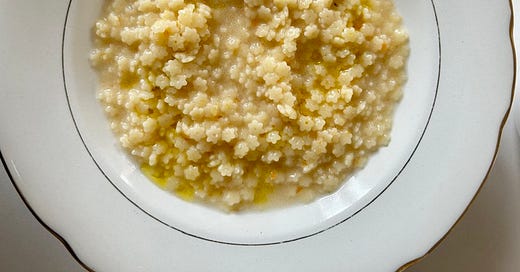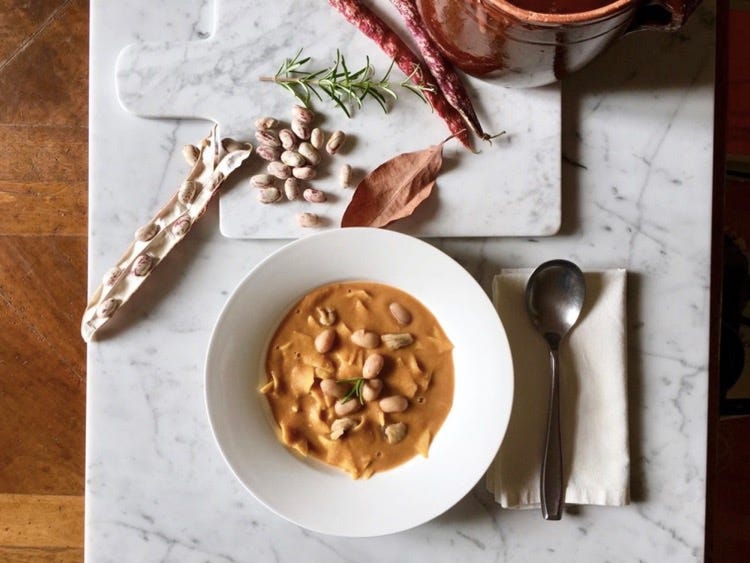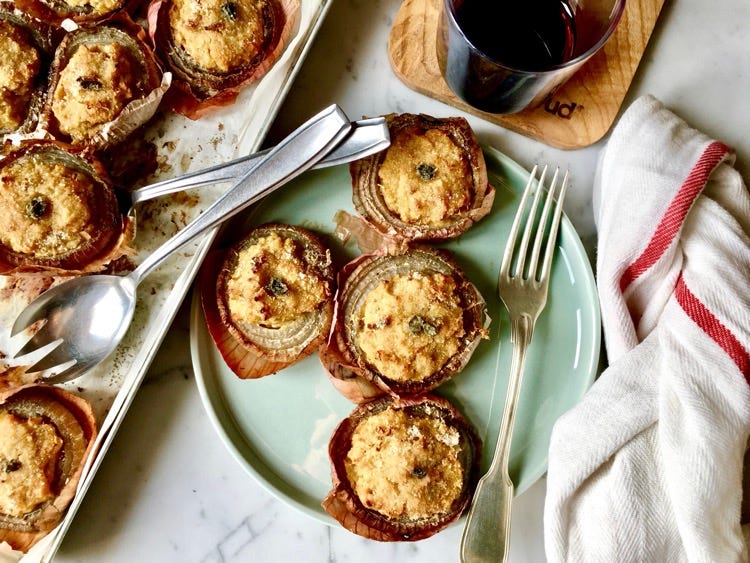A home cooking manifesto
Pastina soup, pasta and beans from Emilia-Romagna, baked stuffed onions
The best food? Homemade food. Without taking anything away from restaurant food, mine is a tribute to a tradition, to the prevailing role of women in the home kitchen, to a feminine gastronomy culture with ancient roots and too little celebrated.
Not to mention that sometimes we forget how quick and easy it is to prepare something healthy and indulgent at the same time. "I do not have time for cooking" is the recurrent justification. If this is the case, remember that it helps to write a list of quick dishes that inspire you, the time each recipe needs, and to do the shopping in advance.
We need to embrace the act of cooking. Less processed food and more meals made from scratch at home.
A manifesto of the virtues of home cooking:
simplicity (of flavors)
knowledge (ingredients, seasons, techniques)
transparency (knowing the ingredients you're eating)
memory
identity
Italian cuisine was born and took shape in home kitchens, which, for a long time, were the only places where food was prepared. In the taverns of the Middle Ages, you could buy a glass of wine or beer, but you had to provide your own food, bringing it from home. In Bologna, at the Osteria del Sole in Vicolo Ranocchi, it's still like that.
Spoiler alert!!!
Don't miss my next newsletter. I'll write a special Via Emilia episode dedicated to Bologna.
The art of home cooking has interlaced with Italy's history over the centuries, reflecting its geography and biodiversity and telling the stories and habits of different social classes. Many of the best Italian recipes were born almost by chance, stemming from the need to avoid wasting food, and we can't date precisely their origins.
Home cooking generates shared memories and identities. Think of pastina soup, a classic children's Italian winter comfort food. It's one of those dishes we all ate, creating a different memory for each person yet shared by complete strangers from North to South of Italy.
Moreover, home cooking is significant, not just related to taste and traditions. And we well know that thanks to Italian emigrants who have, over time, been ambassadors of Italian culinary culture. For them, recreating the flavors of home was a way to reaffirm their identity and soothe their nostalgia. Something similar happens still today.
For all these reasons, home cooking represents a tangible and intangible heritage of knowledge and flavors.
About the best tortellini bolognesi
Christmas is a few weeks away. Someone asks, "Which are the best in Bologna?" Everyone mentions the names of chefs and restaurants. Suddenly, my friend Serena makes the point of the conversation.
The best tortellini are the ones your grandmother makes.
Sic et simpliciter. Perfect synthesis.
Our gastronomic memory encodes the flavors of ragù, tortellini, Sunday roast chicken, Nonna's ciambella, and tiramisù, to name a few iconic dishes of Italian home cooking, throughout a family culinary lexicon that is destined to guide our palate throughout our lives, more or less consciously.
I believe that home cooking represents, everywhere in the world, the ἀρχή (from ancient Greek arkè = principle, origin) of every personal experience. In the same way, home cooking is the origin of the cuisines we associate today with specific countries or geographical areas. Naturally, it is possible to educate the senses even in adulthood, developing a solid understanding of flavors we did not grow up with.
Throughout my life, I have tasted excellent dishes created in the kitchens of trattorias and restaurants, even Michelin-starred ones, to which I always gladly return. But when I think of the cuisine I love most, the one that nourishes and comforts me, the one tied to memories and identity, rituals and care, only home cooking remains on the table.
Home cooking, 3 manifesto recipes
Pastina soup
The pastina soup was the first meal after a seasonal illness had forced me to bed. That dish was a welcome back to life.
Guess to come home tired. On the way, the cold stings your skin, and a blade of icy wind finds a way to creep between the knots of your scarf. You open the door feeling chilled and in a bad mood when the comforting scent of gently simmering broth comes to meet you and welcome you home. The world ceases to be hostile, and home is always the best place to return.
Is it the same for you?
The Recipe
2 serves
Ingredients
30 g of carrots
30 g of celery
30 g of onion
2 bay leaves, optional
about 100 g of Parmigiano Reggiano rind, optional
2 g of coarse salt
500 ml of cold water
120 g of stelline pasta
10 g of grated Parmigiano Reggiano or Pecorino cheese
5 g of grated Cheddar
2 cheese triangles (about 30 g each) or another soft cheese
olive oil to taste
Method
If you are using Parmigiano rind, wash it under running water and use a grater to remove the top layer of rind.
Place the carrot, celery, onion, and coarse salt in a large pot. If you have them, add the bay leaf and Parmesan rind.
Cover the ingredients with cold water.
Put the pot on the stove, bring the water to a boil, lower the heat, and continue cooking over a small stove on medium-low heat for 30 minutes.
Turn off the broth and, using a slotted spoon, remove vegetables, rind, and bay leaves. Taste and add salt if needed. Keep aside the Parmesan rind and vegetables for other uses.
Bring the broth back to a boil ( if it is too much, set aside 150-200ml and keep it in the fridge for a few days.) Add the pastina and stir through. Cook until al dente (refer to package instructions) and stir occasionally to prevent clumps.
Pour the pastina soup onto the plates, cover with broth, add the grated cheeses and stir. Place 1 cheese triangle in the center of each bowl, add a drop of olive oil or some flakes butter, and serve it with more Parmigiano aside.
Tips
Pastina means small pasta, which comes in various different shapes. The pastina is cooked in a simple broth (brodo). That time, I used stelline pastina, which are tiny star-shaped pasta.
You can prepare the broth in advance and keep it in the refrigerator for a few days.
Parmesan rind: it enriches the broth with loads of umami flavor. To keep them on hand, save your leftover parmesan rinds in the freezer.
Consider to puree the vegetables. Discard the parmesan rind, then use a slotted spoon to transfer the vegetables to a food processor. Add a couple of broth ladles and blend until the vegetables are smooth. Pour the vegetable cream back into the pot and bring to a boil to cook pastina.
Grated Parmigiano Reggiano adds a cheesy richness, making the broth slightly creamy. Pecorino Romano can also be used. To make it a vegan pastina, substitute it with a plant-based parmesan or nutritional yeast.
Olive oil or butter flakes to end. Sometimes, I love to add a drizzle of olive oil right before serving, which enhances the taste and rich goodness. Other times, I prefer butter. Butter can be added whilst cooking the pastina or directly into the dish.
Pasta and Fagioli from Via Emilia
That pasta and beans have an almost firm consistency and a round, rich, and meaty flavor. Even if there is no meat in this recipe from the cucina povera.
At home, pasta and beans were called maltagliati and beans soup because of the fresh pasta, maltagliati, to be precise. Sometimes, Grandma would also soak a handful of dried chestnuts the night before with the beans.
When the table and the food followed the seasons, this winter soup warmed and satisfied. I can't say how many variations exist in Italy; this is from my family repertoire.
The recipe
4 serves
Ingredients
1 carrot
1 stick of celery
1 small yellow onion
30 g of olive oil
30 g of butter
a few sage and bay leaves
100 g of dried borlotti beans
20 g of red wine, optional
3 g of tomato paste
2 liters of water
3 g of coarse salt
130 g of maltagliati or other fresh pasta like quadrucci
grated Parmigiano Reggiano, to serve
Method
The night before, soak the beans and, if you like, a handful of dried chestnuts in a large bowl full of cold water.
The next day, drain the beans, rinse them under running water, and set aside.
Choose a large pot and set it aside.
Finely chop the onion, carrot, and celery and cook for a few minutes over low heat in a bit of olive oil and a knob of butter.
Then, add the sage and bay leaves.
Pour the beans into the pan. Stir again and cook for 3 minutes.
Add the red wine, let it evaporate while stirring over high heat, add the tomato paste, stir, and then add the water.
Bring to a boil, lower the heat, and cook for about an hour and a half on low heat or until the beans are tender.
Turn off the heat and remove 1/3 of the beans from the pot. Remove sage and bay leaves.
Use an immersion blender to blend the contents of the pot until creamy. Taste and add salt if needed.
Bring the broth back to a boil, and then add the pasta and the whole beans. Lower the heat and cook for a few minutes, stirring.
Serve the soup hot with grated Parmesan aside.
Tip
If you like, before serving, sprinkle with chopped fresh parsley.
Baked stuffed onions
The onions we used at home were almost always from Medicina, a village in the Bolognese countryside bordering Imola, where I come from.
When you have a good onion in your hands, fleshy and slightly aromatic like the yellow one from Medicina, you can only bake it in the oven and serve it as a side. If you have some stale bread, use it to make stuffed onions.
Cooking in the oven, under the ashes, or on the embers was a typical home cooking method in rural Italy. Unfortunately, we have lost much of that wealth of knowledge and recipes. For this reason, sharing a recipe from the cucina povera repertoire is always a celebration.
My maternal grandmother used to make the filling with breadcrumbs or stale bread softened in milk. Then she added an egg yolk, and a tablespoon of Parmesan cheese. I'll give you my version, without egg and enriched with chopped capers and grated lemon rind.
You can serve the dish as a side or as part of a meal consisting of several vegetable dishes that can be placed together on the table.
Each onion is different, and even if I indicate how many onions I used, it is likely that after cooking them in the oven to soften them, you will get a different amount of pulp from mine. This is mainly due to the water in the onions and how much pulp you remove from each onion. In short, it's a recipe a occhio (by eye).
The recipe
4 serves
Ingredients
4 yellow onions
10 g of salted capers
100-150 g of bread (stale or fresh)
25 g of grated Parmigiano Reggiano
olive oil, nutmeg, oregano, salt to taste
grated rind of half an organic lemon, optional
Method
Preheat the oven to 170C (338F) degrees.
Remove the ends and the peel, then cut the onions in half (I kept part of the peel, as you can see from the photo).
Line a baking tray with parchment paper, arrange the onions, and season with olive oil and a sprinkling of oregano.
Bake the onions in the hot oven for an hour or until soft.
In the meantime, rinse the capers under running water to remove the salt (do it even if they are in vinegar), dry them, and chop finely. Set aside.
If using dry bread, soak it to soften it; if using fresh bread, chop it in a mixer.
Mix the bread with a pinch of salt and nutmeg. Set aside.
When the onions are ready, let them to cool for a few minutes outside the oven (without turning it off). Using a spoon, remove the central part of the pulp, discard the green soul, and blend it.
Mix all the ingredients for the filling in a bowl. Add more bread if the blended onion pulp is very watery. If, on the other hand, the filling seems too firm, add a little water or milk.
Fill the onions, forming a little dome using a spoon, and bake for 15-20 minutes. If you like, use a whole caper as a decoration (add it before baking).
Serve the stuffed onions hot or at room temperature.
Tip
If the filling is not enough, add some more breadcrumbs. If it is too much, make croquettes to bake in the oven and serve with the stuffed onions.
Let’s keep the conversation going.
Write to me at tortellinico@gmail or follow me on Instagram.
If you enjoyed this newsletter, please click on the little ❤️ below ⬇️ and share it. New subscribers can sign up here.








“recreating the flavors of home was a way to reaffirm their identity“—so true and so important. When my daughter comes for lunch over and says, “your house smells just like Nonna’s did” it makes my day. And my daughter’s house smells like Nonna’s house too.
Wow that is quite a decadent pastina. When I was a child, it was one Star brand stock cube, pastina and oil. If I had a tummy ache, then no stock cube, just salt. I still make this when I'm sick. I love what you said about "a feminine gastronomy culture." Women have been excluded from chef culture for many reasons, but where do the chef's get their ideas? From the women who do this every day of their lives.